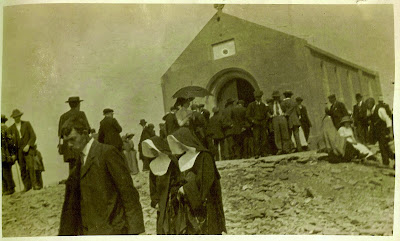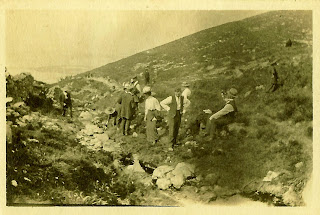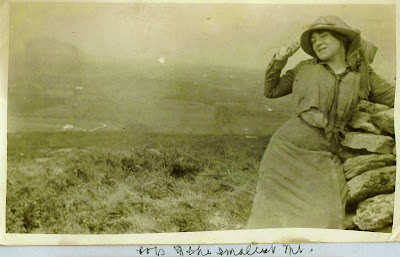Benita (McGinnis) McCormick
(1889 – 1984)
Though in her later years my great-aunt Detty, Benita (McGinnis) McCormick, often reminisced about her trip to France and Ireland in 1913, I don’t recall her talking about her pilgrimage to Croagh Patrick (Gaelic for Saint Patrick’s Mountain and pronounced Crōk Patrick). Luckily, these photographs from her scrapbook show us she was there. Had the first photo below not been labeled, I could not have been able to look it up and then identify the others, which bore no captions. “Pilgrimage to Croagh Patrick,” she wrote under it, “most west spot in Ireland, Westport.”
 |
| The caption reads, “Pilgrimage to Croagh Patrick, most west spot in Ireland, Westport.” Probably taken on Sunday, July 27, 1913, also known as Reek Sunday. |
 |
| Pilgrims, some of whom may be my ancestors, make their way along the rocky shale path on pilgrimage to the top of Croagh Patrick, or Holy Mountain, Reek Sunday, July 27, 1913. |
Situated 2510 feet above sea level in County Mayo, western Ireland, the peak is revered in Irish history as the place where in 441 A.D., Saint Patrick, who introduced Christianity to Éire and became its patron saint, spent the 40 days of Lent in fasting and penance. From there, Saint Patrick also is said to have banished the snakes and demons from the Emerald Isle.
Since then, pilgrims, some of them barefoot, have made their way up the rocky terrain and sometimes steep path of loose shale to the cairn, or summit, to pray and pay their respects. The climb takes about two hours up and an hour-and-a-half down in good weather, but it can take longer in the fog, rain, and snow. (You can see a video of the climb up Croagh Patrick here.)
The two main pilgrimage days are in the summer, about a fortnight apart. The first is on the last Sunday in July, also known as Reek Sunday. The second is on August 15th, the Feast of the Assumption of the Blessed Virgin Mary.
As Benita and her traveling companions were staying with her relatives in Ireland during the summer of 1913, the timing would have been just right for their pilgrimage to this sacred ground. One can imagine her Irish cousins inviting her to join them.
What an experience it must have been! In the photograph here, a 23-year-old Benita triumphantly stands at the summit cairn overlooking the islands of Clew Bay, at the pinnacle of her youth.
 |
| The summit cairn, “unofficial” summit of Croagh Patrick. Shown today, it looks about the same as it did a century ago. Courtesy Wikipedia; in the public domain. |
************
Copyright © 2014 Linda Huesca Tully

